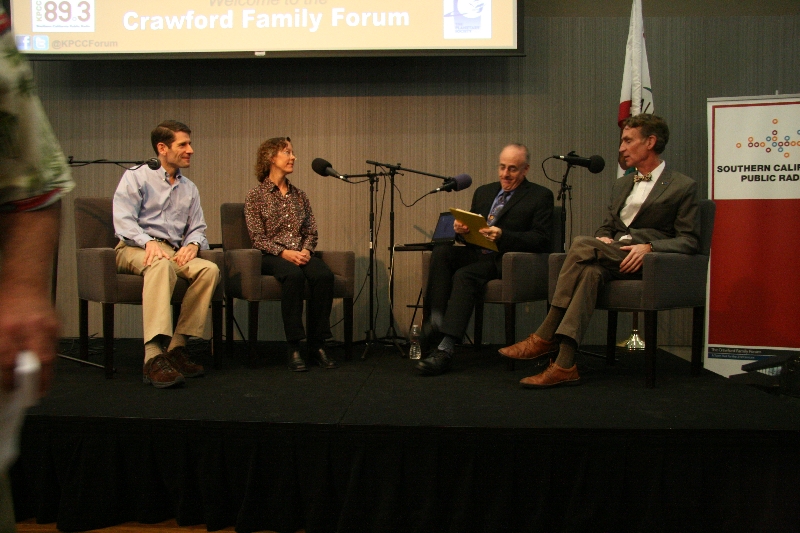
Mat Kaplan (center right) is the host of Planetary Radio chatting to guests John Callas (JPL MER) and Joy Crisp (JPL MSL) to the left and of course Bill Nye on the far right.
Planetary Radio Live – hosted by KPPC at the Crawford Family Forum in Pasadena on December 17th was a treat to the packed audience.
The key guests of the show were John Callas and Joy Crisp from JPL. The audience learned about the important discoveries made by the Spirit and Opportunity rovers after more than eight years of incredible service. These discoveries are now going to be expanded upon by the new Mars Science Laboratory (“Curiosity”) which is currently on-route to Mars (scheduled for landing August 15 2012).
Here are some key things presented:
Although the mission is not about finding life on Mars – it is about finding direct evidence for the types of chemicals and an environment that would have been compatible with life having a chance to form millions or billions of years ago.
One very “space-age” instrument on the new lander is a powerful laser that will zap nearby rocks (up to 21 feet away) – causing a puff of vaporized material that will be measured by other on-board instruments. As Bill Nye pointed out – this is an interesting up-side-down version of “War of the Worlds”. Rather ironic that we are sending a lander with a “ray-gun” to Mars. The “Earthlings are coming… the Earthlings are coming”
Curiosity is 5 times heavier than the much smaller Opportunity/Spirit Rovers.
It is powered by a radioactive power source which means it will be able to operate throughout the Martian year including the winter time (Spirit/Opportunity need to be hibernated during the winter as their solar panels do not receive sufficient sunlight to maintain full operations).
The amount of data transmitted from Curiosity will be approximately double that of what the MER could manage. This is due to improvements to the uplink capabilities of Curiosity. That means more photos/science data!
Other presenters included the Planetary Societies own Emily Lakdawalla (Science and Technology Coordinator) and Bruce Betts (Director of Projects).
Emily shared the facts on how color photos are captured using black&white cameras with multiple filters – and how sometimes – simple image manipulation to compensate for a moving camera platform (the spacecraft) and the objects of focus (e.g. the moons of Saturn) can sometimes be construed as a big cover-up by NASA of some secret alien bases.
Bruce Betts gave a very informative What’s Up presentation on the highlights for astronomical viewing from the Earth over the next month.
I will conclude by reflecting on just how inspiring these events are. Bill Nye provides his signature wit couples with a mastery of presenting/translating complex scientific matters (rocket science) in a form that is both entertaining and highly informative. In the end.. the audience is left inspired by the opportunities that space exploration of our solar system provided to all humankind.




